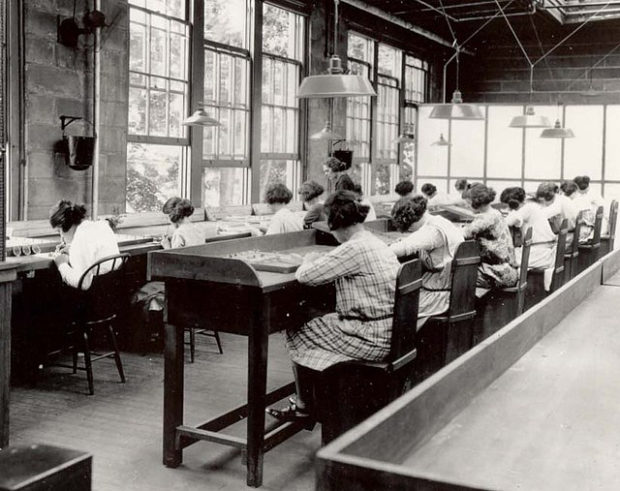These Women Toiled Away In Watch Factories, Without Any Idea That They Were Being Exposed To A Radioactive Element With Deadly Consequences

In 1898, Marie Curie– a physicist from Warsaw, Poland– made the groundbreaking discovery of radium.
Only a little over a decade later, the strong radioactive element was successfully used to treat cancer. But, the so-called miracle element’s adverse effects still remained largely unknown.
After World War I began in 1914, there was a substantial demand for military dials and watches. Throughout the United States, factories dedicated to creating these war-time necessities started to pop up.
Radium became renowned for its success in treating cancer as well as its glowing and luminous properties. So, many commercial manufacturers began to incorporate radium into products such as cosmetics and toothpaste.
The element’s glow also sparked inspiration among the production of military dials and watches. If painted with radium, the hands of the clocks would glow in the dark.
Thus, radium became a staple of these world war-spurred factories. Since painting such tiny dials is a tedious and meticulous job, though, young women became the ideal employees for factory owners.
Hundreds of women, later known as the “radium girls,” became coveted for their smaller hands that could produce highly detailed paintwork.
While working in the factories, radium dust would spew into the air causing the women’s skin, hair, and clothes to glow. At the time, the devastating effects of over-exposure to radium were unknown.

Wikimedia Commons; pictured above women paint radium onto watches in a factory
Sign up for Chip Chick’s newsletter and get stories like this delivered to your inbox.
Instead, the women found the glow intriguing and fashionable. Many would wear gowns to work in order to make them shine for their evenings out. Others would even paint their teeth using radium to brighten their smiles.
Additionally, factory supervisors recognized how minuscule the dial surfaces were. In turn, the women were instructed to lick their paintbrushes in order to create a thin and fine pointed brush. This led to women ingesting radium daily while on the job.
The women were not all glow-happy without cause, either. Most did question the element’s safety but were simply told it was safe. So, these practices continued until the element’s effects began to reveal themselves.
One of the first women to experience the physical effects of radium exposure was named Amelia Maggia– also referred to as “Mollie.” Mollie worked Radium Luminous Materials Corp.– later known as the United States Radium Corp. (USRC)– located in Orange, New Jersey.
In December 1921, she began complaining of a toothache and visited her dentist. The dentist believed her molar needed to be extracted. Afterward, though, the toothache did not stop.
She eventually returned to the dentist, who removed a second tooth right next to the original. Still, her pain was relentless.
During a third visit to the dentist, Mollie’s doctor noticed that neither of her two molar wounds had healed. Instead, the pockets had grown together and were seeping pus and blood.
The dentist believed that Mollie was in need of surgery to remove an abscess in her jaw. After opening her gums, though, the dentist was in for a shocking discovery.
Mollie’s jaw was completely disintegrating. After investigating the bone with his finger, the dentist watched Mollie’s jaw bone crumble like ashes beneath his touch.
Rather than removing an abscess as he had previously planned, the doctor ended up removing Mollie’s entire disintegrating left jaw. And by the summer of 1922, the remnants of Mollie’s jaw, along with fragments of her inner ear, were also removed.
The doctor did not know that radium exposure had caused Mollie’s bone cells to be stripped of calcium and turn to dust. In just eight short months, Mollie’s supposed toothache turned fatal, and she passed away in September of 1922.
And Mollie was not alone in her suffering. Growing numbers of women began to experience the deadly effects of radium, too. Some developed cataracts, throat cancer, skin cancer, loose teeth, and hair loss. One woman even suffered from a collapsing spine.
For about two years, the women’s employer vehemently opposed any connection between their fatal illnesses and the company’s work practices. Still, controversy began to swirl through the public domain.
In hopes of saving their business reputation, the USRC commissioned an independent study of radium. To their dismay, the study found that exposure was, in fact, fatal and that the factory women had indeed died from the radium-filled paint.
Instead of accepting this and discontinuing commercial use of the harmful element, the company commissioned more studies to support its business interests. Unsurprisingly, these studies opposed the independent research and continued to tout radium as safe.
It was not until 1925 that radium was finally proven to be fatal. That year, Harrison Martland– a pathologist– developed a test that confirmed the factory workers had died from radium ingestion.
The growing radium industry attempted to damage Martland’s credibility. But, the radium girls began to fight back, too.
In 1927, the women sought out attorney Raymond Berry who agreed to fight their case. Ill and suffering, many of the girls were left with months to live. Thus, their only option was to accept a settlement.
While the settlement made radium a cover story worldwide, no real change happened until over a decade later when, in 1938, a radium girl named Catherine Wolfe Donohue finally sued the Radium Dial Co. and won.
This case was groundbreaking, not just for the radium girls but also for establishing employers’ roles in the health and safety of employees.
It was one of the first cases where a company was actually held responsible for wrongdoing and eventually led to the revolutionary creation of the U.S. Occupational Safety and Health Administration.
Unfortunately, most of the radium girls did eventually pass from devastating illnesses. Although, their sacrifices are forever remembered for upending work environment expectations and placing the burden of safety on employers.
Additionally, radium went on to serve other important purposes throughout United States history. Most notably, the element was used during the Manhattan Project’s creation of numerous atomic bombs.
If the radium girls had not spoken out, thousands of other war workers might have experienced similar fates. The U.S. Atomic Energy Commission has credited the women with allowing them to create safe handling protocols for the element.
If true crime defines your free time, this is for you: join Chip Chick’s True Crime Tribe.
More About:Human Interest





